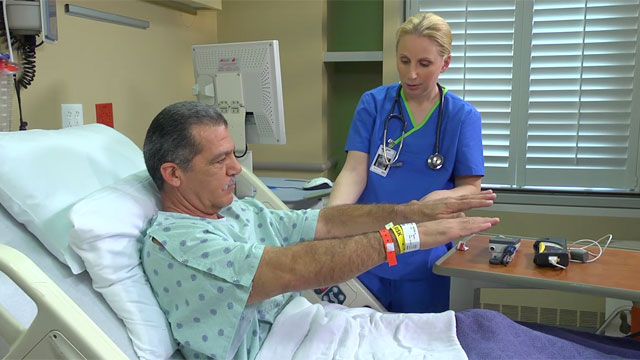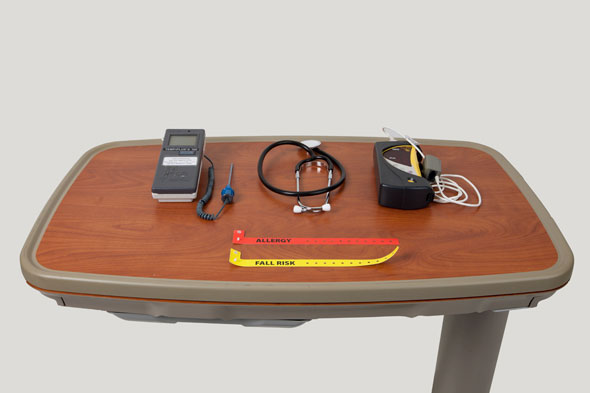Preoperative Nursing Care
Select a Skill:
- » Performing a Preoperative Assessment
- » Promoting Family Support and Participation
- » Teaching Postoperative Exercises
- » Preparing a Patient for Surgery
Take the Review Test:

Safety
- Ensure the completion of operative informed consent permits, blood work, testing electrocardiogram [ECG]), and any other ordered procedures based on American Society of Anesthesiologist (ASA) guidelines.
- Coordinate diagnostic testing to ensure that the surgeon and anesthesia care providers have the information necessary to determine the patient’s surgical and postoperative risks.
- Know the rationale for and extent of the planned surgery. Each surgical procedure requires a different type of nursing care.
- Ensure that the preoperative checklist has been completed. Include the global initiative of the World Health Organization (WHO) Surgical Safety Checklist.
- Assess the patient’s fall risk.
- Implement the Universal Protocol for Preventing Wrong Site, Wrong Procedure, Wrong Person Surgery before any surgical procedure.
- If the planned surgery involves laterality (right versus left), multiple structures (e.g., fingers, toes, lesions), or multiple levels (e.g., spine), perform a final verification, including a site marking by the person performing the procedure.
- Ensure that medication reconciliation is carried out on admission. In particular, be sure to ask if the patient takes a beta blocker.
Equipment
(Roll cursor over items to see labels)

Stethoscope
Pulse oximeter
Thermometer
Allergy arm band (as needed)
Fall risk arm band (as needed)
Delegation
The skills of assessment and teaching may not be delegated to nursing assistive personnel (NAP). Each state has its own rules regarding the delegation of related skills. Following are examples of skills that may be delegated, depending on the scope of practice for NAP in your state:
- Perform basic infection prevention and control practices.
- Assist with care of the patient who requires monitoring or comfort measures.
- Assist with care of the patient with nausea and vomiting, or the patient who is receiving intravenous fluids and oral intake.
- Assist with care of the patient with thermoregulatory problems, including hyperthermia and hypothermia.
- Assist with care of the patient on continual antiembolism devices who requires assistance with ambulation.
Preparation
- Determine the patient’s ability to answer questions about his or her health history and the planned surgery.
- Discuss advance directives with the patient and family. If the patient has a DNR order and has opted to alter it during the intraoperative period, ensure that the medical record clearly indicates when the DNR order is to be reinstated.
Follow-up
- Have the patient describe the surgical procedure and its benefits and risks.
- Compare all assessment data with the patient’s baseline and expected normal values.
- Have the patient repeat the preoperative instructions to ensure that he or she understood them.
- Monitor the patient for signs and symptoms of anxiety, and ask how the patient and family are feeling.
Documentation
- Document all preoperative assessment findings and preparations.
- Document the patient’s condition on transfer to the operating room.
- Document the presence of any allergies/sensitivities on the patient’s armband, in the medical record, and in the medication administration record.
- Record the disposition of the patient’s valuables/belongings, such as if they were locked up according to agency policy or sent home with the patient’s family.
- Report the lack of a signed and witnessed consent form or patient’s failure to maintain NPO status and any action taken.
- Report and record the patient’s cultural practices and/or religious beliefs that might affect perioperative care and any modification made to the plan of care.
Review Questions
1. What is the primary purpose of the preoperative assessment?
 To compare all assessment data with expected normal values
To compare all assessment data with expected normal values To notify the surgeon of abnormal laboratory results
To notify the surgeon of abnormal laboratory results To obtain baseline vital sign values
To obtain baseline vital sign values  To identify conditions or factors that may compromise the surgical outcome
To identify conditions or factors that may compromise the surgical outcome
2. What is the best way for the nurse to assess a preoperative patient for possible latex allergy?
 Review the medical record for documentation of a latex allergy.
Review the medical record for documentation of a latex allergy. Ask the family whether the patient has ever had a reaction to latex.
Ask the family whether the patient has ever had a reaction to latex. Ask the patient if he or she has a latex allergy or is not allowed to use anything made of rubber.
Ask the patient if he or she has a latex allergy or is not allowed to use anything made of rubber. Specifically mention latex gloves and balloons when asking about items to which the patient may have had an allergic reaction.
Specifically mention latex gloves and balloons when asking about items to which the patient may have had an allergic reaction.
3. Which part of the preoperative assessment might the nurse delegate to the nursing assistive personnel (NAP)?
 Encourage NAP to keep the patient in a comfortable position.
Encourage NAP to keep the patient in a comfortable position. Direct the NAP to perform a complete health history.
Direct the NAP to perform a complete health history. Ask the NAP to find out if the patient has any allergies.
Ask the NAP to find out if the patient has any allergies. Ask the NAP to determine if the patient is at risk for falling.
Ask the NAP to determine if the patient is at risk for falling.
4. On which areas would the nurse focus when completing a preoperative physical examination?
5. During a preoperative assessment, why would the nurse ask the patient about his or her response to previous surgeries?
 To predict the patient’s response to anesthesia
To predict the patient’s response to anesthesia  To identify anatomic and physiologic alterations that may affect care
To identify anatomic and physiologic alterations that may affect care  To help estimate the amount of time the patient will be hospitalized
To help estimate the amount of time the patient will be hospitalized  To determine the amount of pain medication the patient will need
To determine the amount of pain medication the patient will need
You have completed the Review Questions for this skill. To take the Review again select the Start Over button. To proceed to another skill select from the dropdown menu. Select the Home or Back button to proceed to the next section.

